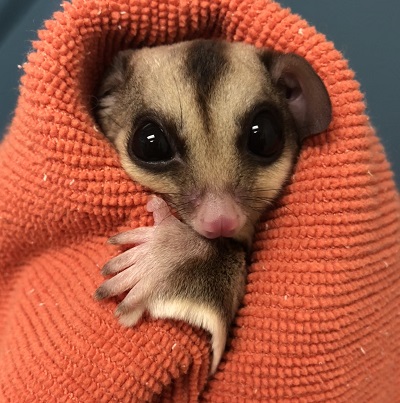
The end of April is almost here and there is no doubt that this April was a most unusual and challenging month. If you were joining us on Twitter for the first time, we want to thank and welcome you to @ExoticPetVets. We also hope you enjoyed our Animal of the Month feature as we tweeted about sugar gliders all month long. But if you missed any of our tweets, you can find them summarized here where you can reference them anytime. Did you know?:
- Sugar gliders (Petaurus breviceps) are small mammals, who are also commonly known as honey gliders, sugar bears or sugar squirrels.
- The sugar glider’s scientific name comes from the Latin and translates to “short-headed rope dancer” (Petaurus = rope dancer, breviceps = short-headed).
- The odd scientific name was given to the sugar glider due to his small size combined with his aerial acrobatic antics.
- Sugar gliders are endemic to Australia, Indonesia and Papua New Guinea.
- They are not native to the Australian island of Tasmania, but were introduced to Tasmania in the 1800’s and are considered to be an invasive species there.
- In Tasmania, sugar gliders are a significant threat to the endangered swift parrot population on the island as they will eat the parrots’ eggs, kill chicks and nesting adult females.
- Not only did people introduce sugar gliders to Tasmania, but people are also making the problem worse. Human activity – notably, deforestation and urbanization – have pushed sugar gliders to compete with swift parrots for space and shelter in trees.
- Predation of female swift parrots by sugar gliders is also changing the parrots’ behaviour. Swift parrots are by nature monogamous, but now there is a severe gender imbalance that is seeing female swift parrots mate with more than one male.
- Fully grown sugar gliders are small, with half of their length being made up of their tails! Their bodies measure 5-7 inches (about 16 cms) on average, with another 5-7 inches of tail length.
- Adult sugar gliders are also very light, weighing anywhere between 80-160 grams. But sugar gliders in captivity are prone to obesity if they are fed a diet with too many calories and don’t get enough exercise.
- Sugar gliders have short, thick grey fur on their backs, legs and tails. They have a black stripe that starts just above their noses, runs down the entire length of their backs and ends just before their tails begin.
- Sugar gliders have light cream-coloured fur on their undersides. Their tails are tipped with black fur.
- My, what big eyes they have! Because they are nocturnal, sugar gliders have huge protruding dark eyes which help them see in the dark.
- My, what big ears they have! Sugar gliders have large bat-like ears that can move independently from one another. They have a fantastic sense of hearing and are able to detect even the softest of sounds.
- One big reason why they’re called sugar gliders is…they glide! A fold of skin or membrane called a patagium is attached to their front and rear ankles and that gives them their gliding ability.
- When they want to glide, the sugar glider will extend his legs out which stretches the patagium, giving his body a parachute-like ability.
- Sugar gliders use their gliding ability to glide from tree to tree while using their tails as rudders. They can glide as much as 45 metres (148 feet)!
- You can tell the difference between female and male sugar gliders by looking at them, which means they are a sexually dimorphic species.
- Female sugar gliders tend to be a bit smaller and lighter than their male counterparts. The stripe of black fur running down their backs also tends to be thinner on the females.
- Male sugar gliders develop three scent glands when they become adults, with two of them presenting as either bald spots or discoloured fur – one on his head and one on his chest. The third male scent glad is in the genital area.
- Because sugar gliders are marsupials, like kangaroos, female sugar gliders have pouches on their bellies in which they carry their babies for about 2 1/2 months after giving birth.
- What do sugar gliders and cats have in common? They both keep themselves very clean with their own personal grooming and don’t need to be bathed.
- But unlike cats, who groom themselves with their tongues, sugar gliders will spit into their hands and then rub their hands over their bodies in order to groom.
- Sugar gliders devote a lot of time each day to grooming. Not only do they groom themselves, but because they are very social animals, they also groom each other.
- The recent Australian wildfires had a devastating impact on sugar gliders and all of Australia’s flora and fauna. Of the animals who survived the flames, countless numbers were injured and/or left homeless or orphaned.
- In just one of many examples of people responding to the call to help Australia’s animals, knitters from around the world used their skills to help sugar gliders and other marsupials who were left orphaned.
This is the third time we have featured sugar gliders as our Animal of the Month. Check out our blog posts from December 2015 and September 2018 to see what we tweeted about rats the first two times around!

